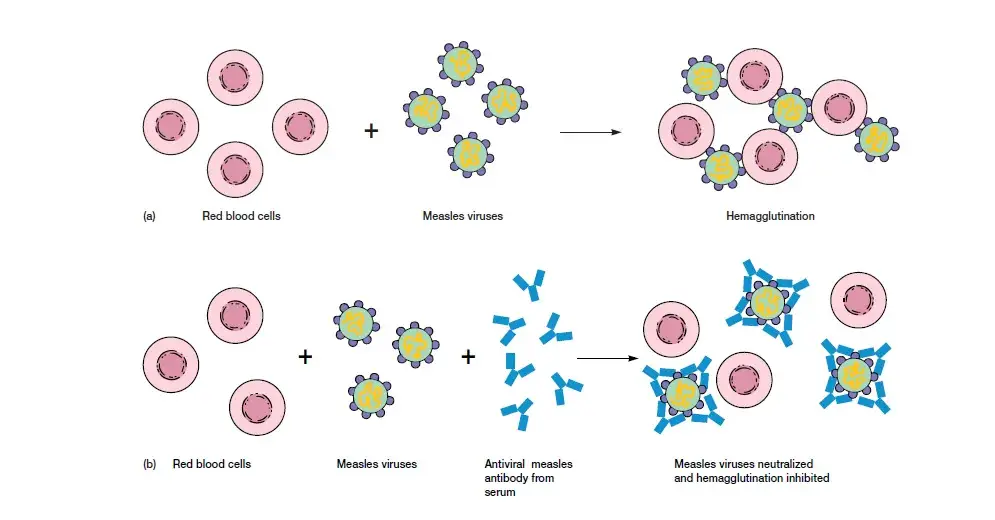The nucleic acids of many viruses encode surface proteins (such as hemagglutinin (HA) of influenza virus) that agglutinate red blood cells (RBC) of numerous species. Hemagglutination is the process by which viral hemagglutinins react with red blood cells to form a lattice of agglutinated cells that settle unevenly in a tube or microtiter well. Unagglutinated cells congregate into a dense button.
Contents
Principle of Hemagglutination Inhibition Test
- When measles viruses and red blood cells come together, hemagglutination occurs (see image a). However, if the serum of a person infected with measles virus is combined with RBC and measles virus, RBC will not agglutinate.
- This occurrence is referred to as hemagglutination inhibition. As the hemagglutinins are occupied and unable to attach and agglutinate RBCs, this occurs due to the presence of antibodies in the serum of the infected individual that neutralise the measles viruses (positive outcome).
- If the patient’s serum lacks antibodies against the surface proteins of the test virus, hemagglutination will occur because surface molecules are free to hemagglutinate red blood cells (negative result).
- The premise of the HAI assay is that antibodies to that specific virus (such as measles virus) will inhibit the virus from attaching to RBC. Therefore, hemagglutination is suppressed in the presence of antibodies.
- If the serum contains no antibodies that react with the measles virus, then all wells will display hemagglutination.
- Similarly, if measles virus-specific antibodies are present, hemagglutination will not occur until the antibodies are sufficiently diluted.
- The presence of non-specific inhibitors of viral haemagglutination and naturally occurring agglutinins of the erythrocytes may complicate the HAI test. In order to prevent misleading positive or negative results, the sera must be processed prior to use.

HAI Titer: The maximum dilution of serum (Ab) that inhibits hemagglutination is known as the serum’s HAI titer.
Quality Control
- Identified positive serum
- Serum has a poor reputation.
- serum and nonantigenic cells (to detect nonspecific agglutination).
- Back titration of the antigen’s hemagglutination activity (to verify that four hemagglutinating viruses (HAU) were examined).
Materials and Reagents
- Red blood cells of a suitable animal (chicken, goose, guinea pig, or trypsinized human O) are collected in Alsever’s solution or heparin.
- Diluent (e.g. bovine albumin veronal buffer) at acceptable pH.
- The elimination of non-specific hemagglutinins from serum.
- Infected culture fluid or standard antigen (e.g., influenza virus preparation) for serology.
Procedure
- Obtain a viral preparation (e.g., influenza) with a known HA titer or determine its HA titer.
- Prepare twofold dilutions of the patient/test serum to be tested, for example from 1:4 to 1:1024.
- Except for the serum control wells, add a fixed dose of virus to each well of a 96-well plate, corresponding to 4 HA units (varies by virus).
- Permit the plate to sit at room temperature for sixty minutes (time varies according to specific requirements).
- Add red blood cells (RBC) and incubate for 30 minutes at 4 degrees Celsius.
- Examine the wells.
Results/interpretation
The maximum dilution of serum (Ab) that inhibits hemagglutination is known as the serum’s HAI titer. A shield of smooth or jagged cells, or an uneven button, shows agglutination. Observing the movement of the red cell button when the plate is tilted may aid in elucidating the endpoint.
This virus sample had a HAI titer of 1280, which indicates that the highest dilution of antibodies that still prevented hemagglutination occurred at a dilution of 1280. At this concentration, the antibodies could still recognise and attach to antigens on the virus.

Uses of Hemagglutination-Inhibition Test
- Infections caused by orthomyxoviruses (influenza), paramyxoviruses (measles, mumps), mononucleosis, arboviruses-togaviruses (including rubella), flaviviruses, and bunyaviruses are commonly diagnosed by the hemagglutination inhibition test.
- Hemagglutination can detect the presence of the virus in infected cell cultures; particular suppression of hemagglutination can determine the identity of the virus or antibodies in a patient’s serum.
- Although influenza viruses can be detected using the hemadsorption test, the hemagglutination inhibition test is the most effective method for isol type (HAI).
Advantages
- The assays for HA and HI are simple, utilise very affordable and readily available equipment and supplies, and deliver findings within a few hours.
- In addition, the assays are well-established in numerous laboratories across the globe, allowing for some degree of credibility, comparability, and standardisation.
Limitations
- For optimal and consistent results, it is necessary to adjust multiple variables, including incubation durations, red blood cell concentration, and red blood cell type.
- Interference and erroneous titer levels might be caused by nonspecific components in the sample. For instance, compounds in the sample besides viral-specific antibodies can hinder agglutination between virus and RBCs, as well as prevent antibody binding to virus.
- Typically, materials are treated with receptor-destroying enzymes (RDE) before to analysis to prevent non-specific inhibition.
- A qualified individual must analyse the HA or HI data by reading the plate and determining the titer values.
- Manual interpretation increases the likelihood of test differences due to the subjectivity of results and the uneven agreement amongst human readers.
- In addition, there is no digital record of the plate or titer determinations, making the first interpretation laborious and typically performed in duplicate. The diversity of potential variables and discrepancies between professional readers might make it difficult to compare laboratory data.
Related Posts
- Radial Immunodiffusion – Principle, Procedure, Result, Uses
- Latex agglutination test – Definition, Procedure, Principle, Advantages, Limitation, Uses
- Rapid Plasma Reagin (RPR) Test – Principle, Procedure, Result, Applications
- Mantoux Test – Procedure, Normal Range and Result Interpretation
- Types of Immunoelectrophoresis










